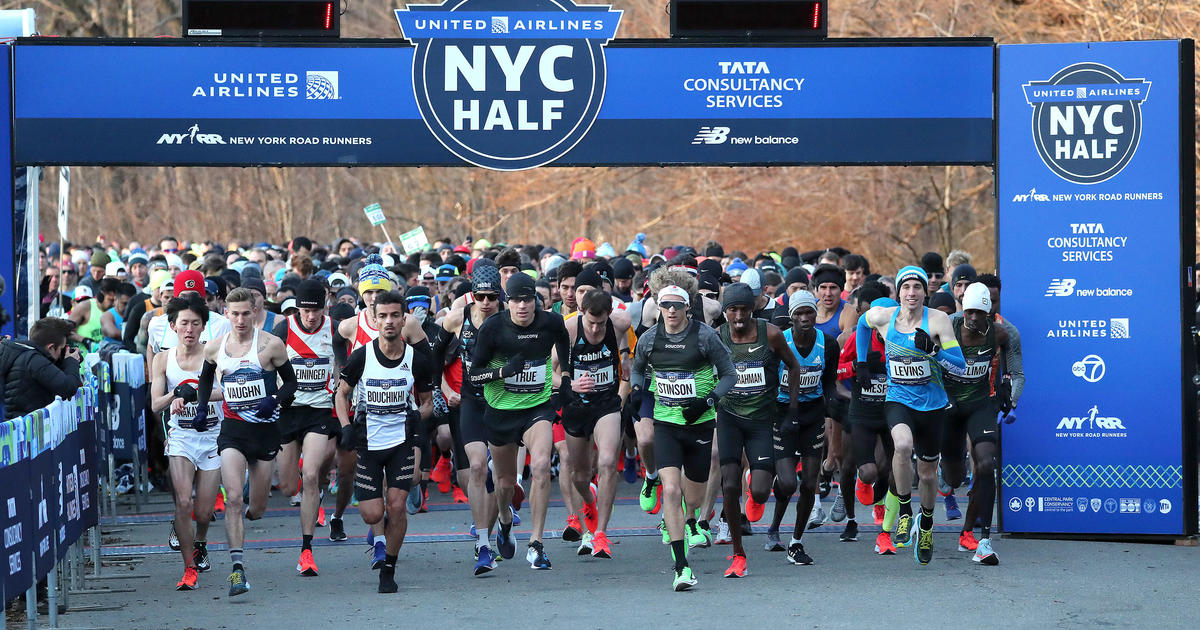Home>Misc>Featured>How Much Harder Is A Marathon Than A Half Marathon


Featured
How Much Harder Is A Marathon Than A Half Marathon
Modified: January 22, 2024
Discover the challenges and differences between a marathon and a half marathon. Learn how much harder the full 26.2 miles can be compared to 13.1. Featured resource for runners.
Introduction
Welcome to the world of long-distance running! If you’ve ever considered challenging yourself with a race, chances are you’ve come across the terms “marathon” and “half marathon”. These two iconic races offer runners an opportunity to push their limits and achieve personal milestones.
In this article, we will explore the key differences between a marathon and a half marathon, focusing on the training requirements, physical toll, mental challenges, race atmosphere, and recovery time. Whether you’re a seasoned runner or a newbie looking to embark on your first long-distance race, understanding the unique aspects of these races will help you make an informed decision and set realistic goals.
Before we dive into the specifics, let’s clarify what a marathon and a half marathon actually are. A marathon is a grueling 26.2-mile race that tests both physical endurance and mental fortitude. It is the ultimate challenge for many runners, requiring months of disciplined training to complete. On the other hand, a half marathon is exactly half the distance of a marathon, coming in at 13.1 miles. While still a significant accomplishment, the half marathon offers a slightly less daunting challenge for those looking to tackle a long-distance race.
Now that we have a basic understanding of what a marathon and a half marathon entail, let’s delve into the key differences between the two races. From the training requirements to the race atmosphere, we will explore the unique aspects of each race to help you determine which one is right for you.
What is a marathon?
A marathon is the epitome of long-distance running, encompassing a 26.2-mile (42.195 kilometers) race. The name “marathon” derives from the ancient Greek legend of Pheidippides, who ran from the city of Marathon to Athens to deliver news of victory in battle. The history and significance of the marathon make it a prestigious and revered race in the running community.
The marathon distance presents a formidable challenge for runners of all levels. Preparing for a marathon requires months of dedicated training, gradually increasing mileage and incorporating speed work and long runs. It demands discipline, perseverance, and mental strength to push through the physical barriers encountered during the race.
Marathons can be participated in by both elite runners and recreational athletes. They are usually organized as major events, complete with official timing, aid stations, and a vibrant race atmosphere. Participants may choose to run in support of a cause or as a personal milestone to achieve. Crossing the finish line of a marathon is a monumental accomplishment, signifying determination and endurance.
During the race, marathon runners may experience a wide range of emotions and physical sensations. The early stages are often filled with excitement and adrenaline, while the later miles can test mental resilience and physical endurance. The marathon is known for its “wall,” a point in the race, typically around mile 20, where runners may hit a physical and mental barrier. Overcoming the wall requires mental fortitude and sheer willpower.
Marathon events also vary in terms of course terrain and difficulty. Some marathons take place on flat, urban routes, while others are known for their challenging hills and scenic landscapes. The Boston Marathon, for example, is renowned for its demanding hills, while the Berlin Marathon offers a flat and fast course favorable for setting personal records.
Ultimately, running a marathon is not just about the physical feat, but also about the journey of self-discovery and personal achievement. It pushes individuals to their limits and rewards them with an immense sense of accomplishment at the finish line. Whether a runner is aiming for a specific time or simply aiming to cross the finish line, running a marathon is a life-changing experience.
What is a half marathon?
A half marathon, also known as a 13.1-mile race (21.0975 kilometers), is a popular choice for runners seeking to challenge themselves with a long-distance race without the full commitment of a marathon. The half marathon has gained significant popularity in recent years, attracting participants of all fitness levels, from beginners to seasoned runners.
Half marathons offer a more accessible and manageable distance compared to the full marathon. They provide an opportunity for runners to set achievable goals and experience the excitement and camaraderie of a race without the extensive training required for a marathon.
Like marathons, half marathons are organized events that include official timing, aid stations, and a festive race atmosphere. Participants have the chance to run alongside other like-minded individuals and draw inspiration from the collective energy of the crowd.
Training for a half marathon typically involves a progressive buildup of mileage and endurance. Depending on an individual’s fitness level and running experience, the training period can range from 8 to 12 weeks. This allows runners to gradually increase their distance and improve their stamina while reducing the risk of overexertion or injury.
While still a significant challenge, half marathons are often viewed as a stepping stone toward marathon completion. Many runners use the half marathon as a training milestone, testing their fitness levels and pacing strategies before taking on the full 26.2 miles.
Half marathons offer a balance between a challenging physical endeavor and a rewarding accomplishment. Crossing the finish line of a half marathon evokes a sense of fulfillment and achievement, as runners experience the satisfaction of pushing their limits and accomplishing a notable athletic feat.
The race experience in a half marathon is relatively shorter than in a marathon, making it ideal for those who prefer a race that can be completed in a shorter time. However, the intensity and level of effort required to complete a half marathon should not be underestimated. The race may still present mental and physical challenges, especially during the later miles when fatigue sets in.
Whether it’s for personal fitness goals, raising funds for a charity, or simply enjoying the thrill of a racing event, half marathons provide an opportunity for runners to participate in a rewarding distance race that offers a taste of the marathon experience without the same level of commitment.
Key differences between a marathon and a half marathon
While both a marathon and a half marathon are long-distance races, there are several key differences that set them apart. Understanding these differences can help you make an informed decision about which race to pursue and what to expect during your training and the actual race itself.
- Distance: The primary difference between a marathon and a half marathon is the distance. A marathon is 26.2 miles (42.195 kilometers), while a half marathon is exactly half that distance, at 13.1 miles (21.0975 kilometers). This discrepancy in distance significantly impacts the training required and the overall duration of the race.
- Time commitment: The training required for a marathon is generally more time-consuming compared to that of a half marathon. Marathon training often involves higher weekly mileage, longer runs, and a greater emphasis on endurance. On the other hand, half marathon training can be more manageable for runners with busy schedules or limited training time.
- Physical demands: Naturally, the longer distance of a marathon places greater physical demands on the body compared to a half marathon. The training for a marathon is designed to build both endurance and stamina to withstand the rigors of a 26.2-mile race. The physical toll of a marathon is generally more significant and can involve slower recovery than a half marathon.
- Mental challenge: Both marathon and half marathon races pose mental challenges, but marathons are often considered more mentally demanding. The prolonged physical exertion and the need to push through fatigue and potential “wall” moments require mental fortitude, resilience, and determination. Half marathons can also present mental challenges, but the intensity and duration are generally lower compared to a full marathon.
- Race atmosphere: Marathons tend to have a more vibrant and energetic race atmosphere due to their larger participant numbers and spectator support. They often attract a diverse range of runners, including elite athletes, charity fundraisers, and recreational runners. Half marathons also boast a spirited atmosphere but may not have the same level of intensity and crowd support as marathons.
- Recovery time: Due to the increased physical demands of a marathon, the recovery time required is typically longer compared to that of a half marathon. It is not uncommon for marathon runners to take several days or even weeks to fully recover from the race. Half marathons, being less demanding on the body, usually involve a shorter recovery period.
Understanding these key differences between a marathon and a half marathon can help you determine which race aligns better with your goals, preferences, and available time for training. Whether you choose the challenge and prestige of a marathon or the attainable distance and faster recovery of a half marathon, both races offer unique experiences and opportunities for personal growth and achievement.
Training requirements for a marathon
Preparing for a marathon is a significant undertaking that requires months of dedicated training and commitment. The training process is designed to gradually build endurance, improve speed, and mentally prepare runners for the challenges they will face during the 26.2-mile race. Here are the key training requirements to consider when preparing for a marathon:
- Mileage: Marathon training involves gradually increasing weekly mileage to build a solid running base. Runners typically start with a comfortable base and progressively increase their mileage over several weeks. This allows the body to adapt to the increased distance and reduces the risk of injury. The peak mileage weeks often range between 40-60 miles, depending on the individual’s fitness level and goals.
- Long runs: Long runs are a vital component of marathon training as they simulate the distance of the race and build both physical and mental endurance. Runners gradually increase their long run distance each week, typically completing a 20-mile run a few weeks before the race. These longer runs help develop stamina and confidence, but should be balanced with proper rest and recovery.
- Speed work: Incorporating speed work into marathon training helps improve running efficiency and increases overall speed. This can include tempo runs, interval training, and hill repeats. These workouts challenge the cardiovascular system and enhance the body’s ability to maintain a faster pace during the race.
- Rest and recovery: Adequate rest and recovery are critical components of marathon training. Rest days allow the body to repair and rebuild, reducing the risk of overuse injuries. In addition to rest days, incorporating easy runs and low-impact cross-training activities, such as swimming or cycling, into the training plan can help facilitate recovery and prevent burnout.
- Nutrition and hydration: Proper nutrition and hydration play a vital role in marathon training. Fueling the body with a balanced diet that includes carbohydrates, proteins, and healthy fats is essential for sustained energy during long runs. Hydration should be a constant focus, both during training runs and throughout the day. Practice nutrition and hydration strategies during training to determine what works best for your body.
- Mental preparation: Marathon training goes beyond physical fitness; it also requires mental preparation. Cultivating mental toughness, developing coping strategies for fatigue and discomfort, and practicing positive self-talk are crucial aspects of marathon training. Visualizing success and setting realistic goals can also help boost confidence and motivation.
It is important to note that marathon training plans can vary depending on individual fitness levels, time constraints, and goals. Consulting with a running coach or following a structured training program can be beneficial for creating a personalized training plan that suits your needs. Additionally, listening to your body and giving yourself ample time to recover is key in preventing overtraining and burnout.
Remember, completing a marathon is a tremendous accomplishment. The training journey allows you to develop physical and mental resilience while pushing your limits. Embrace the process, be consistent with your training, and trust in your preparation and ability. With dedication, perseverance, and a well-structured training plan, you can cross the finish line of a marathon and achieve your running goals.
Training requirements for a half marathon
Preparing for a half marathon involves a focused training plan that gradually builds endurance, improves speed, and mentally prepares runners to conquer the 13.1-mile distance. While the training for a half marathon may not be as intense as that of a full marathon, it still requires commitment and dedication. Here are the key training requirements to consider when preparing for a half marathon:
- Building a base: Just like marathon training, a solid base is important for half marathon preparation. This involves establishing a comfortable mileage base before progressively increasing weekly mileage. This phase allows the body to adapt to the demands of running and reduces the risk of injury.
- Long runs: Long runs play a crucial role in half marathon training. These runs gradually increase in distance, with the goal of reaching a distance slightly longer than the half marathon itself. Building up to a 10-12 mile long run helps develop the physical and mental endurance needed to complete the race comfortably.
- Speed work: Incorporating speed work into training can help improve running efficiency and increase overall speed. This can include tempo runs, interval training, and fartlek runs. These workouts challenge the cardiovascular system, improve anaerobic fitness, and help runners maintain a faster pace during the race.
- Rest and recovery: Rest and recovery are crucial components of half marathon training. Rest days allow the body to repair and adapt to the training stimulus, reducing the risk of overuse injuries and burnout. Active recovery, such as easy runs or cross-training activities, can also aid in recovery and prevent excessive fatigue.
- Nutrition and hydration: Proper nutrition and hydration are essential for optimal performance during training and on race day. Eating a balanced diet that provides adequate carbohydrates, proteins, and healthy fats will support training and recovery. Hydration should be a focus, both during runs and throughout the day, to maintain optimal performance and prevent dehydration.
- Mental preparation: Half marathon training involves mental preparation as much as physical training. This includes setting realistic goals, practicing positive self-talk, and visualizing success. Developing mental strategies to push through fatigue and overcome challenges encountered during the race is fundamental for a successful half marathon experience.
While the training requirements for a half marathon may be less demanding compared to a full marathon, it is still important to approach training with dedication and consistency. Following a structured training plan or seeking guidance from a running coach can provide valuable insights and ensure that you are properly prepared for race day.
It’s important to listen to your body throughout the training process, especially in terms of rest and recovery. Pushing too hard or neglecting recovery can lead to fatigue, injuries, and suboptimal performance. Be mindful of the balance between training and rest, allowing your body to recover and adapt to the demands of the training plan.
With commitment, perseverance, and a well-structured training plan, you can confidently complete a half marathon and achieve your running goals. Enjoy the training journey, embrace the physical and mental challenges, and celebrate your accomplishments along the way. On race day, trust in your preparation and enjoy the experience of crossing the finish line of a half marathon.
Physical toll of a marathon compared to a half marathon
Completing a marathon and a half marathon both require a considerable physical effort, but the extended distance of a marathon places more intense demands on the body. It’s important to understand the potential physical toll of each race in order to adequately prepare and recover. Here are some key differences in the physical toll between a marathon and a half marathon:
- Duration: One of the notable differences between the two races is the duration. A marathon can take significantly longer to complete compared to a half marathon. This extended duration means that marathon runners are on their feet for a longer period of time, resulting in increased stress and fatigue on the body.
- Muscle fatigue: The extended distance of a marathon can lead to greater muscle fatigue compared to a half marathon. The repetitive impact and sustained effort required to cover the extra miles can result in muscle soreness and tightness, especially in the legs and lower body. Proper strength training and conditioning are essential for mitigating muscle fatigue during marathon training.
- Energy expenditure: Marathon runners expend more energy over the course of the race compared to half marathon runners. The body relies heavily on stored glycogen as the primary fuel source during endurance events, and depleting these glycogen stores can lead to fatigue and a decrease in performance. Proper nutrition and hydration strategies are crucial to sustain energy levels throughout a marathon.
- Potential for overuse injuries: The increased mileage of marathon training and the duration of the race increase the risk of overuse injuries, such as stress fractures, tendinitis, and muscle strains. The repetitive impact and prolonged endurance exertion can put stress on joints, tendons, and muscles. Proper rest, recovery, and listening to the body are essential to prevent overuse injuries.
- Hydration and electrolyte balance: Proper hydration and electrolyte balance play a vital role in both marathon and half marathon races. However, the longer duration of a marathon requires stricter attention to hydration and electrolyte replenishment. Dehydration and electrolyte imbalances can lead to fatigue, muscle cramps, and decreased performance. Understanding individual fluid requirements and implementing a hydration strategy is crucial for marathon runners.
- Cardiovascular strain: The cardiovascular system experiences significant strain during both marathon and half marathon races. However, the longer duration and increased distance covered in a marathon impose a greater demand on the heart and lungs. Training the cardiovascular system through long runs and adequate endurance training is necessary to meet the demands of a marathon.
It’s important to note that the physical toll of a marathon and a half marathon can vary depending on individual factors such as fitness level, running experience, and training preparation. Proper training, gradual progression of mileage, sufficient rest and recovery, and a balanced approach to nutrition and hydration can help minimize the physical impact and optimize performance in both races.
Remember to listen to your body, pay attention to any signs of excessive fatigue or injury, and adjust training accordingly. Prioritize proper rest, recovery, and injury prevention strategies to ensure a successful and enjoyable race experience.
Mental challenge of a marathon versus a half marathon
The mental challenge of a marathon versus a half marathon is one of the key distinctions between the two races. While both races require mental fortitude, completing a marathon presents a unique set of mental challenges that differ from those experienced in a half marathon. Here are the main differences in the mental challenges of a marathon versus a half marathon:
- Longer duration and sustained focus: A marathon requires a longer duration of mental focus compared to a half marathon. The extended time on the course can test a runner’s mental endurance, as maintaining concentration, staying motivated, and managing boredom become more significant factors. Mental resilience is crucial for sustaining mental focus throughout the race and pushing through challenging moments.
- The “wall” and overcoming doubt: The marathon is notorious for its “wall,” a point in the race where runners may hit a mental and physical barrier. Around the 20-mile mark, fatigue sets in, and doubts may creep into a runner’s mind. Overcoming this mental hurdle requires immense mental strength, determination, and the ability to push through the discomfort and fatigue. Half marathons, while challenging, often do not have the same level of mental doubt and physical exhaustion associated with hitting the wall.
- Managing pacing strategies: Marathons require strategic pacing over an extended distance. Runners must strike a balance between starting conservatively to conserve energy and finishing strong. Maintaining a steady pace and resisting the temptation to start too fast requires mental discipline and self-control. In a half marathon, the shorter distance allows for a more aggressive pacing strategy, reducing the mental focus required for careful pacing.
- Dealing with physical discomfort: Both marathons and half marathons involve physical discomfort, but the prolonged duration of a marathon can amplify the mental challenge of dealing with physical pain and fatigue. Mental strategies and positive self-talk are essential for managing discomfort and staying motivated when fatigue sets in. In a half marathon, while physical discomfort is still present, the shorter distance makes it more manageable mentally.
- Mental resilience and self-belief: The mental challenge of a marathon lies in maintaining mental resilience and self-belief throughout the race. Negative thoughts and self-doubt may arise, but having a strong belief in one’s abilities and the ability to overcome challenges is crucial. The mental battle of a marathon often involves continuous positive self-talk and mental strength to push through moments of doubt.
- Risk of mental burnout: The prolonged mental focus and demands of a marathon increase the risk of mental burnout compared to a half marathon. The mental challenge of training for and running a marathon requires a high level of commitment and dedication over an extended period. It’s important to implement mental recovery strategies, such as taking rest days, engaging in mindfulness practices, and seeking support from a running community, to mitigate the risk of mental burnout.
While both marathons and half marathons require mental strength, the mental challenge of a marathon is often more intense and can test a runner’s resilience, determination, and ability to push through physical and mental barriers. Mental preparation, such as visualization exercises, positive self-talk, and mental resilience training, is crucial for success in both races, but particularly in a marathon.
Understanding and embracing the mental challenge of a marathon and being prepared to overcome moments of doubt and fatigue are essential. Developing mental strategies and maintaining a positive mindset throughout the race can make a significant difference in achieving your goals and crossing the finish line empowered.
Comparison of race atmosphere and crowd support
The race atmosphere and crowd support play a significant role in the overall experience of a marathon or a half marathon. While the atmosphere and support can vary between races and locations, there are some distinguishing factors that differentiate the race atmosphere and crowd support between the two distances:
- Participant numbers: Marathons generally attract larger participant numbers compared to half marathons. The sheer size of a marathon can create a vibrant and electrifying race atmosphere, with runners of varying abilities and goals. The larger participant numbers often result in a more diverse and energetic ambiance that can be motivating and inspiring.
- Race energy: The energy level at a marathon tends to be higher compared to a half marathon, partially due to the larger participant numbers. The excitement and anticipation build as thousands of runners gather at the starting line, creating an electric atmosphere that can propel runners forward. The marathon’s longer duration allows for a sustained energy level throughout the race.
- Crowd support: Marathon races often draw substantial crowd support, especially in iconic events or races held in major cities. Spectators line the course, cheer for runners, and provide encouragement along the way. The crowd support can be a source of motivation, particularly during challenging moments of the race. Half marathons also have their share of crowd support, but the level of spectator participation tends to be lower compared to marathons.
- Course entertainment: Marathons often feature additional entertainment along the course to enhance the race atmosphere. Local bands, cheerleading squads, and other performers may be stationed at various points, adding to the excitement and energy. Half marathons may have some entertainment elements as well, but the focus is typically more on the running experience and personal achievement.
- Community involvement: Marathons, particularly those held in major cities, tend to garner significant support from the local community. Residents often come out in large numbers to cheer on the runners, create impromptu water stations, and offer words of encouragement. The community involvement adds a sense of camaraderie and support throughout the race, making the marathon experience more memorable.
- Impact on the runner: The race atmosphere and crowd support can have a profound impact on a runner’s performance and overall race experience. The cheers and encouragement from spectators can boost morale, energize tired legs, and provide the mental strength needed to push through challenging moments. The vibrant race atmosphere and enthusiastic crowd support can create an unforgettable experience and contribute to a runner’s sense of accomplishment.
It’s important to note that the race atmosphere and crowd support can vary between different marathons and half marathons. Some races may have a more subdued atmosphere, while others may be known for their fervent community involvement and enthusiastic spectators. Researching and selecting races with a reputation for strong crowd support can enhance the overall race experience and contribute to a runner’s motivation and performance.
Regardless of the distance you choose, the energy, encouragement, and sense of camaraderie from the race atmosphere and crowd support can make a significant difference in your race experience. Embrace the cheers, draw inspiration from the community, and let the race atmosphere carry you across the finish line.
Recovery time after a marathon and a half marathon
Recovery is a crucial aspect of any race, as it allows the body to repair and rejuvenate after the physical exertion of running. The recovery time needed after a marathon or a half marathon can vary based on factors such as individual fitness level, training preparation, and race conditions. Here is a comparison of the recovery time generally required after completing a marathon versus a half marathon:
- Marathon Recovery: Completing a marathon imposes a significant physical toll on the body due to the prolonged duration and increased distance covered. The recovery time after a marathon typically ranges from several days to several weeks. Immediately after the race, it is essential to focus on rehydrating, refueling, and resting. Many marathon runners experience muscle soreness and stiffness in the days following the race, which gradually subsides with time. Depending on the intensity of the race and individual recovery capacity, light activities such as walking or easy cross-training exercises can be incorporated within the first week, gradually increasing in intensity as the body recovers. It is common for runners to refrain from intense training for at least two to four weeks after a marathon to allow full recovery and prevent overuse injuries.
- Half Marathon Recovery: The recovery time after a half marathon is generally shorter compared to a marathon. Many runners can recover within a few days to a week after completing a half marathon. The immediate post-race period should still focus on rehydration, replenishing glycogen stores with nutritious food, and getting adequate rest. Stretching and foam rolling can help alleviate muscle tightness and soreness. Light, low-impact activities such as walking, cycling, or swimming can be incorporated a day or two after the race to aid in recovery. Depending on individual fitness levels and recovery capacity, most runners can gradually resume their regular training routine within a week of completing a half marathon.
- Factors Affecting Recovery: Various factors can influence the recovery time after a marathon or a half marathon. These include the runner’s fitness level, training volume and intensity, overall health, age, and race conditions. Adequate nutrition, hydration, and rest play crucial roles in facilitating recovery for both distances. It is important to listen to your body, give yourself ample recovery time, and avoid rushing back into intense training too soon, as this can increase the risk of injury and hinder long-term progress.
Recovery strategies for both marathon and half marathon runners typically include proper nutrition, hydrating adequately, getting sufficient sleep, and incorporating active recovery techniques such as stretching and foam rolling. Additionally, seeking professional treatments such as massage or physical therapy can aid in the recovery process.
Remember, each runner’s recovery timeline may vary, so it is crucial to respect your body’s signals and not compare your recovery progression to others. Gradually easing back into training and avoiding excessive mileage or intensity too soon can help prevent overuse injuries and facilitate long-term progress.
Regardless of the race distance, prioritizing recovery allows the body to heal, rebuild, and adapt. Embrace the recovery process as an integral part of your running journey, and give yourself the time and attention you need to fully recover before embarking on your next running endeavor.
Conclusion
Choosing between a marathon and a half marathon is an exciting and personal decision that should align with your goals, abilities, and preferences. Both races offer unique challenges and rewards, and understanding the differences between them is essential for making an informed choice.
A marathon is the epitome of long-distance running, requiring extensive training, physical endurance, and mental resilience. It tests the limits of the human body and mind, providing a life-changing experience for those who complete the 26.2-mile journey. The physical toll, mental challenge, and race atmosphere of a marathon are unparalleled, making it an ideal choice for those seeking the ultimate running achievement.
A half marathon, on the other hand, offers a more manageable distance while still providing a significant challenge. It provides a stepping stone for runners looking to test their limits before taking on the full marathon and offers a more accessible option for those with time constraints or limited training availability. The half marathon still requires training, mental fortitude, and a commitment to excellence but offers a slightly less demanding physical and mental toll than the full marathon.
When considering which race is right for you, it is essential to assess your personal goals, available training time, and preferred race atmosphere. Reflect on your fitness level, endurance capacity, and mental resilience to determine which race will provide the ideal balance of challenge and accomplishment. Don’t forget to factor in the recovery time needed after each race to ensure a healthy and sustainable training approach.
Ultimately, whether you choose a marathon or a half marathon, the journey will be a transformative one. Embrace the training process, push your limits, and celebrate your accomplishments along the way. Be inspired by the vibrant race atmosphere and the unwavering support of fellow runners and cheering crowds. And most importantly, savor the unmatched sense of achievement as you cross the finish line, knowing that you have conquered a remarkable physical and mental challenge.
Whichever race you choose, running a marathon or a half marathon will undoubtedly leave you with a profound sense of personal accomplishment, an enduring memory, and a newfound belief in your own strength and resilience. So lace up your running shoes, set your sights on the goal that speaks to you, and embark on this unforgettable journey.









